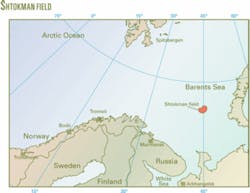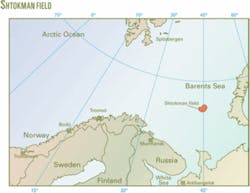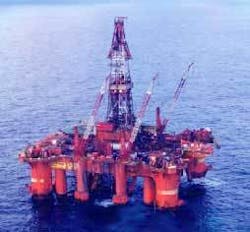Russians drilling giant Shtokman field with Norsk Hydro
OAO Gazprom has begun exploratory drilling in the giant Shtokman field in the central part of the Russian sector of the Barents Sea with Norway’s Norsk Hydro ASA.
Russia has had short-term agreements with an assortment of foreign companies for more than 15 years, but is expected to announce long-term partners for the Shtokman project later this year. Two Norwegian companies, Norsk Hydro and Statoil ASA, appear to be front-runners, although Italy’s Eni SPA is in eleventh-hour discussions to take on part of the project.
Norway and Russia have shared ideas on Arctic development for the last 4 years at annual INTSOK meetings alternating between Stavanger and Moscow. The most recent conference took place in Moscow in January 2006.
Norway and Russia each have interests in the Barents Sea. In 25 years of exploration, since the first Barents well spudded in June 1980, through August 2005, the Norwegian Petroleum Directorate reports that 63 wells were drilled in the western Barents. In 2005, the Statoil ASA, Norsk Hydro, and ENI Norge AS group drilled the Uranus wildcat, and ENI Norge drilled a development well at Goliath (OGJ, June 13, 2005, p. 45).
At the Offshore Technology Conference in Houston earlier this year, Julia Nanay, senior director in the country strategies group at PFC Energy, said that by 2020, 20% of Russia’s hydrocarbons will come from its offshore fields, and two thirds of the future offshore production is expected to come from the Barents Sea and Kara Sea (OGJ Online, May 3, 2006).
The Russian part of the Barents Sea is estimated to contain about 22 billion boe (OGJ, June 13, 2005, p. 45).
The giant Shtokman gas-condensate field (Shtokmanovskoye) was discovered in 1988, followed by appraisal drilling 1990-95. Hydro participated in drilling the fourth appraisal well.1
The field is east of Murmansk, about 555 km offshore, in 350 m of water. Reserves at Shtokman have been estimated at 3.2 trillion sq m of natural gas and 31 million tonnes of condensate, in four main reservoirs between 1,900-2,300 m.2
In January 2006, the Russian Federation Nature Ministry’s State Commission for Mineral Reserves estimated the Shtokman C1+C2 reserves at 3.7 trillion cu m of natural gas and more than 31 million tonnes of condensate.
In 2000, the Russian government signed a production-sharing contract with ZAO Sevmorneftegaz, controlled by Gazprom and Rosneft.
Partnership attempts
In 1989, Norsk Hydro, Conoco, and the Finnish Barents Group had an agreement with the Russian government for cooperative work in Shtokman field, later voided.3
In 1995, Hydro, Finland’s Fortum Oil & Gas Oy (and subsidiary Neste Engineering), Conoco, and Total SA began studying the project with Gazprom and Rosneft, but the cooperation agreement expired in late 2002.
Norsk Hydro Oil & Energy’s President, Morten Ruud, said early on that Gazprom would probably select several companies to work on the project. “Even for Gazprom the Shtokman development requires such huge investment there is need for several partners. That is why we might very well end up in cooperation with some of the companies we have already worked with.”3
In 2004-05, Gazprom signed preliminary contracts were signed with Hydro, Statoil, Total, ConocoPhillips, and Chevron Corp.
Gazprom’s top executive, Alexey Miller, said in June 2004 that Hydro could be one of the most important partners based on its unique technological position.4
The two Norwegian companies, Hydro and Statoil, have more experience in northern Norway and the Barents than the others. Statoil has assembled the Snøhvit LNG project and recently announced that it will install subsea compressors in 250 m of water in Aasgard field, Norwegian Sea. The company said its experience with seabed technology could be useful if it is selected as a partner for Shtokman LNG development (OGJ Online, July 20, 2006).
In September 2005, Gazprom announced at a press conference in Moscow that it was considering these five companies for a 49% partnership stake in the Shtokman field and that a decision would be announced within 4-6 months. Gazprom said that four other companies had sought to participate but were rejected: ExxonMobil Corp., Royal Dutch Shell PLC, and Japan’s Mitsui Corp. and Sumitomo Corp.5
CEO Miller said Gazprom would set up a consortium with two or three of the five shortlisted companies and that share allocation would be decided after consortium members were chosen.5
Partners are yet to be formally announced, but at the Group of Eight summit that opened in St. Petersburg on July 15, 2006, Russian Energy and Industry Minister Viktor Khristenko said that foreign partners for the Shtokman project could be announced in October, according to Dow Jones Commodities News.
On July 16, 2006, Russian President Vladimir Putin said he would prefer Norwegian partners to US-based companies, United Press International reported.
Shtokman rig
Gazprom’s Elena Panyukova told OGJ that it is using the Deepsea Delta semisubmersible, provided by Oslo-based Norsk Hydro, to drill the seventh Shtokman well. Hydro had been using the rig to drill in Vale field and on Oseberg Vestflanken.
The rig is under contract to Hydro through first-quarter 2009, from owner Odfjell Drilling AS, based in Bergen, Norway (Fig. 1). The original 18-month contract, worth 600 million kroner (about $98 million or $182,000/day) was announced in March 2004 and ran from third-quarter 2004 to early 2006. It provided options for six 6-month extensions (3 additional years).
The ODECO Ocean Ranger-design semisub was built in 1981 at the Rauma Repola Oy yard in Pori, Finland, initially operated under the name West Delta, and was modified in 1996. After modification, it was “employed continuously in Norway” before Odfjell bought it in 2001 and renamed it the Deepsea Delta.
The self-propelled, third-generation rig has a water-depth capacity of 3,300 ft and a maximum drilling depth capacity of 25,000 ft. It has eight main columns, a deckload capacity of 3,500 tonnes (7,000 kips) and is equipped with Oilwell E-3000 drawworks and three Oilwell A1700-PT mud pumps.
The well control system is centered on an 18¾-in. Hydril blowout preventer rated to 15,000 psi, trimmed for H2S service, and a Hughes KFDS 500-psi diverter system, handled with a 250-tonne Marenco BOP carrier and overhead crane. Cameron’s subsea hydraulic control system includes a Cameron hydraulic subsea BOP system includes choke and kill manifold gate valves with hydraulically operated valves on the choke manifold. The BOP and Christmas tree can be installed in a single run using the skidding system on the cellar deck.
Odfjell says the rig is “especially well suited to work in harsh environments” such as the Barents Sea because its structure is certified to -20º C. and it has double barriers in the drilling mud and pit systems to prevent fluid loss.
The driller’s cabin is made by Hitec ASA, based in Forus, Norway (part of National Oilwell Varco), and is equipped to run the smart drilling instrumentation system. SDI provides a graphical interface with streaming, real-time data. The driller controls the system using the Cyberbase platform.
Latest Shtokman well
Hydro announced last September that it would cooperate with Gazprom, Sevmorneftegaz, and general contractor OOO Gazflot (a wholly owned subsidiary of Gazprom) to plan and drill the seventh Shtokman well during summer 2006.6 Bengt Lie-Hansen, senior vice-president of Hydro Oil & Energy, is the head of the company’s Shtokman team.
In late July, Gazprom announced that it had started drilling the seventh well in the Shtokman field. The wellsite is about 550 km from the Kola Peninsula, in 340 m (1,115 ft) of water.
According to the Barents Observer, the well will take about 100 days to drill, and several Norwegian companies are at work.7 Tubulars are being supplied by the Murmansk subdivision of Norway’s Reinertsen Group. The MS Skandia Admiral supply vessel, owned by Norway’s DOF ASA, shuttles crew and supplies to Shtokman from Kirkenes harbor twice weekly. The Kirkenes Base is owned by the three Norwegian companies: Coast Center Base (CCB), Kimek, and Barlindhaug. The Deepsea Delta semisubmersible rig is Norwegian owned (Odfjell) and operated (Hydro).
It is good to see Sevmorneftegaz involving experienced Norwegian companies because of their understanding of the precautions necessary while working in the fragile, arctic marine environment. Perhaps the next step will be for Russia to adopt protective environmental regulations that parallel those enacted by Norway, for future Barents development.
John Hattenberger, LNG director of Gazprom Marketing & Trading Ltd. of London, said that Shtokman gas is “an excellent candidate for LNG” because it is too remote to be sold via pipeline to Europe (OGJ, Feb. 20, 2006, p. 30). He said the field would be developed in three phases, each 15 million tonnes/year, and that the first phase of LNG development would begin in 2012.
At the G-8 conference, Russian Minister Khristenko said “Shtokman will launch the concept of a real global market for liquefied natural gas.”
In early August, the chief executive of Eni, Paolo Scaroni, said he is talking with Gazprom about building a $2.5 billion LNG facility near St. Petersburg with a capacity of 8 billion cu m/year.8 The contract is worth €1.94 billion. Although Italy’s ENI is not on Gazprom’s short-list of potential foreign partners, Scaroni said his company is interested in joint LNG projects in the Baltic and Barents Seas, including Shtokman field development.
References
- “Hydro on Shtokman shortlist,” Sept. 16, 2005, www.hydro.com.
- http://www.offshore-technology.com/projects/shtokman/
- “Aiming for Shtokman: Norsk Hydro in Russia,” Scandinavian Oil Gas Magazine, Dec. 12, 2003, www.scandoil.com.
- “Gazprom appoints Hydro as partner in Shtokman,” June 4, 2004, www.hydro.com.
- “Russia’s Gazprom names potential partners for Shtokman gas project,” Sept. 19, 2005, http://newsfromrussia.com/main/2005/09/19/63128_.html
- “Hydro to cooperate on Shtokman well 7,” Sept. 14, 2005, www.hydro.com.
- “Norwegian summer at Shtokman,” July 20, 2006, www.barentsobserver.com.
- “Eni Looking to Build LNG Plant in Russia,” AFX News Ltd., Aug. 7, 2006.


